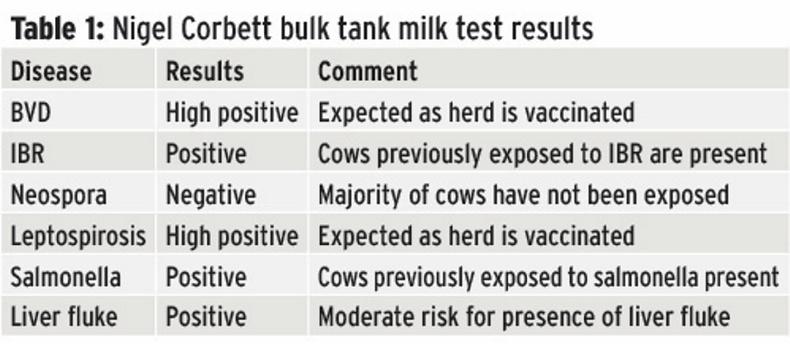Making decisions based on reliable information is important in all aspects of farming, from breeding to grassland management to herd health.
Bulk tank milk testing gives a useful overview of the antibody levels in cows’ blood for various diseases. High antibody levels indicate that cows have had exposure to an infection at some point and have produced antibodies to fight it.
Regular bulk tank testing (around four times a year) is recommended as it gives a more accurate time frame on when exposure to an infection took place and it allows for seasonal trends, particularly with parasites.
Individual testing of cows after positive or high positive results are found in a herd health screening is useful to identify cows that could be individual carriers of diseases. Culling decisions can then be based on individual results.
Some types of bulk tank tests can also differentiate between wild and vaccine strains of antibodies, which is recommended if some cows in a herd have been vaccinated for a disease.
Interpretation
The bulk tank milk testing is not without its limitations, as the sensitivity (number of false negatives) and specificity (number of false positives) from the test ranges for various diseases.
Young stock, dry cows and any milk that was kept out of the tank on the day of sampling are not included in the test. In larger herds, dilution effects may not show up antibodies from a positive cow.
This means that interpretation of bulk tank milk test results and any subsequent changes to herd health plans should only be carried out after consultation with a vet.
Nigel Corbett Banbridge, Co Down
A bulk tank milk test taken in mid-July has showed up some health issues in the herd and after consulting our vet we are now addressing this through an updated vaccination plan.
We previously only vaccinated for leptospirosis and BVD. Health costs on the farm last year were low at £4,839, or £43 per livestock unit, and vaccinations accounted for 11% of this.

This is the first time we have carried out a herd health screening on a bulk tank milk sample and the results were positive for both Salmonella and IBR (see Table 1). The test results were high positive for antibody levels for both BVD and leptospirosis, but this was to be expected as we vaccinate for both and the test did not differentiate between vaccine and wild strains.
All 100 cows and 15 in-calf heifers have got their first salmonella injection and are due a six-week booster injection this week. We plan to start an IBR vaccination programme as cattle are housed and 35 maiden heifers will also get the IBR vaccine. Injections for IBR will be given at the same time as BVD vaccination.
The two initial salmonella vaccines will cost £10/cow and the IBR injection will cost £3/cow. One salmonella booster is then required each year and IBR injections will be given once every six months.
This updated vaccination programme will increase health costs on the farm by around £2,000 in the first year. This will be a significant increase in health costs but we see it as a sound insurance policy for the business given that the test results show that the two diseases have been present in the herd at some point.
There were 20 cows bought in this year which were previously vaccinated for salmonella and IBR and will therefore have low immunity to the diseases if a vaccination programme is not continued here.
It is also important to have a comprehensive animal health plan in place as calving becomes more compact, which is the case on this farm.
With herd mortality already quite low at 4.5% last year, we are hopeful that the extra investment in vaccinations will improve herd performance in terms of production and fertility.
Six acres of the grazing platform that were burned off with glyphosate last month were ploughed at the end of last week. However, wet weather over the weekend has stopped any progress with preparing the seedbed and delayed getting grass seed sown.
We have seed bought with a mixture of the tetraploids Abergain and Astonenergy and the diploid Abermagic ready for when conditions improve.
Plans that we had to reseed a silage field this autumn now look likely to be postponed until next year with the wet weather.
Damper conditions have not impacted grazing as milking cows are still at grass night and day. Half the herd is now dry and only cows within two weeks of calving are housed.
Calving has started, with six cows calved so far. There should be 30 cows calved by the end of the month and 75% of the herd will be calved by the end of December.
Cows are receiving pour on for roundworms and lungworms as they are dried off. At calving, cows are drenched for rumen and liver fluke and get fly repellent pour on.
A new heat detection system has been installed and cows will be getting activity meters around their necks. The aim is to have the system up and running for the start of breeding in December.






 This is a subscriber-only article
This is a subscriber-only article












SHARING OPTIONS: